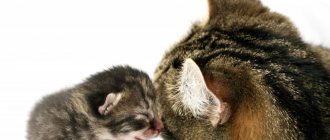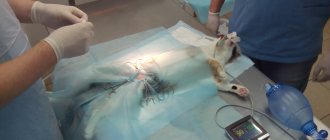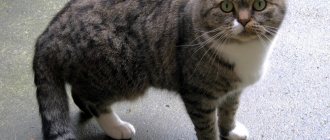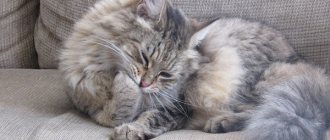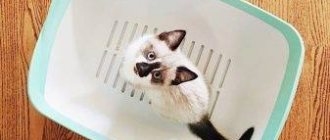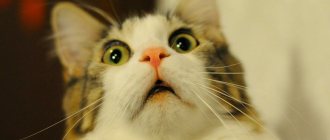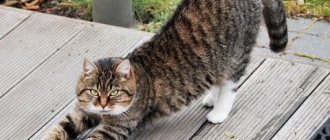11444Administration
2
It is very important for the owner to notice the signs of childbirth in a timely manner for the owner, because this is what makes it possible to accurately determine the duration of the birth process and, if necessary, provide assistance to the pet. If you miss the start of lambing, it may be difficult to determine whether intervention is necessary. If the animal’s condition is good and the process is going correctly, then intervention is not required. When the birth of kittens is delayed, a veterinarian is necessary. After examining the four-legged woman in labor, he will determine the need for one or another assistance.
Complications during childbirth are more often observed in purebred animals and too young females, whose body has not yet fully formed. Outdoor cats, which have the opportunity to constantly be in the fresh air and spend time actively, rarely encounter problems during pregnancy and lambing due to the fact that their bodies are strong and well-trained. He can easily bear the load and easily prepares himself for the birth of kittens without any intervention. However, signs of impending birth in a cat that lives at home should alert their owners. If there is a week left before the birth of the offspring, a female who gives birth not for the first time may have completely absent signs.
© shutterstock
Mating and early pregnancy
How to determine if a cat is pregnant? A healthy cat is usually ready to breed within 8-10 months after birth. In some individuals, estrus may begin even earlier - already at six months of age.
However, this does not mean at all that it is time to start looking for a cat. It is optimal to carry out the first mating at the age of 1-1.5 years. By this point, the cat’s body will be sufficiently strong and will be finally ready to bear offspring. So, the mating happened.
But how can you determine if a cat is pregnant at home? It is quite difficult to answer this question. From the moment of mating until the end of the heat, the cat continues to ask the cat, lie around and show all the signs of “desire”. So it’s not possible to immediately understand how successful the mating was.
The first obvious symptoms of pregnancy in cats become visible only at 3 weeks. In general, the length of pregnancy in British cats can vary between 8-9 weeks.
Determining the gestational age of cats is quite problematic. But there are still some guidelines. Between 15 and 21 days after conception, the cat's nipples become swollen and pink. This is what indicates that kittens will soon appear in the house.
The behavior also changes slightly: the pet becomes calmer. During this period of pregnancy, cats experience an increased appetite.
Features of physiology
Every owner should understand at least a little about these issues. Where his experience and knowledge are lacking, a veterinarian is needed. Today we’ll talk about the age at which a cat can become pregnant. From the moment of her first heat, she is physiologically ready to become a mother. This ability is sometimes retained until old age. There is no such thing as menopause in cats. That is, the reproductive age lasts from the first estrus until death. This must be communicated to the owners even before the furry beauty crosses the threshold of their home.
Cat nutrition during pregnancy using the example of British cats
In order for a British cat to have a pregnancy without pathologies, she needs to be fed correctly. So it’s time to say a few words about the diet of a pregnant British woman and her diet.
Immediately after mating, you need to increase the amount of feed by about 10%. This will not harm even if conception does not take place. However, to prevent your cat from becoming fat, you should not increase the amount of food in the bowl, but introduce one additional feeding per day.
As soon as the first symptoms of pregnancy appear in cats, nutrition should be increased by another one and a half times.
At about 7 weeks, the cat begins to eat significantly less, and closer to giving birth, it may even refuse food altogether. Pregnancy of cats is “to blame” for this and diseases have nothing to do with it. This behavior is due to the fact that the animal’s abdominal cavity is almost completely filled with unborn offspring. During this period, the amount of food can be slightly reduced, returning the pet to its normal diet.
Now about the diet. For the entire period of pregnancy in British cats, fish and cheap food should be completely excluded.
But without fail, the cat should be given beef scalded with boiling water, milk and dairy products. Depending on the preferences of the expectant mother, this could be cottage cheese, kefir, low-fat yogurt, etc.
It is recommended to offer your little predator raw vegetables such as carrots and cabbage, as well as buckwheat and rice porridge. Most likely, a pregnant British cat will choose one of these products to give her unborn kittens the substances they need for development.
How often can a cat give birth?
This is another important question that veterinarians are also often asked. Now we know what time a cat can become pregnant, but we still need to understand how to be careful during the year. If her living conditions are good and her nutrition is adequate, estrus will occur with enviable regularity, and you will be faced with the problem of placing the offspring in good hands.
Of course, this frequency is typical for animals that have free access to the street. If there are cats living next door, then surprises cannot be avoided. In this case, it is extremely important to consider how many months a cat can become pregnant. After all, the offspring of a young female will most likely not be viable.
Even if your beauty is still nursing her babies, she may go into heat, and if there is a male nearby, she may become pregnant. This leads to exhaustion, weight loss, inflammatory diseases and other problems. As we said above, if the owner approaches breeding responsibly, then he must exclude such a possibility.
Second half of pregnancy
Visually, pregnancy in cats becomes noticeable at 5-6 weeks. At this point, the pet is gaining some weight. This is the time when a pregnant cat's belly begins to grow. The kitty is getting rounder, and if you put your hand on the tummy, you can feel the developing kittens moving.
Another week later, at about 50-56 days of pregnancy, with careful palpation you can feel the heads of the developing babies. If you wish, you can even determine by touch how many there will be. You just need to do this very carefully.
During this same period of pregnancy, cats begin to actively look for a place for the upcoming birth. They wander through all available rooms, carefully studying all the nooks and crannies. Finally, at 8-9 weeks, the pet begins to prepare for childbirth.
She moves little and sleeps a lot. But at this time, kittens that are still born are most active. At this point, the owner must understand that the British cat’s pregnancy is coming to an end, and be fully prepared for the upcoming birth of new lives.
How does childbirth occur in cats?
Childbirth in British cats occurs differently. Much depends on the individual characteristics of the body, body type and many other factors. However, there are a number of characteristic features that every owner should be aware of.
The first sign of impending labor is the release of the birth plug. Often this process goes unnoticed by the owners, since cats tend to hide this pinkish clot. So you have to navigate by the receding waters.
How childbirth occurs in cats - watch the video:
If this happens, then there is very little time left before the appearance of cat offspring. Typically, a cat does not require human assistance during birth. However, if she reaches out to her owners, it means that she needs to be supported and calmed with light stroking.
The first stage of labor begins with contractions, which help dilate the cervix. At this moment, the fetus is already beginning to pass through the birth canal. How to detect contractions in a cat? In most cases they are visible visually. In addition, the cat is quite restless during contractions and meows a lot.
She is in pain, so the owners need to try to calm the animal down. At the second stage, the kitten is born. Often, fluid comes out of the birth bladder first. Then the cub itself appears. Usually kittens enter head first, but if it happens differently, then this is also not a pathology. However, in such a situation, the cat and baby may need human help.
At the last stage, the uterus comes to a calm state and the so-called afterbirth comes out. This is followed by a short break, after which the process of giving birth to the next kitten begins. This break usually lasts from 10 minutes to an hour.
Sometimes it happens that after the birth of several cubs, the birth of a British cat is interrupted. At the same time, the young mother behaves completely naturally, taking care of the already born offspring. However, after some time, labor continues and the remaining kittens are born. For cats, such breaks are quite normal. But it’s worth keeping an eye on your pet at this time. The duration of such physiological rest can vary from 12 to 36 hours.
And a few words about the afterbirth. Usually cats eat it. However, you should not let your pet do this more than twice. Otherwise, the new mother may experience vomiting or diarrhea. In addition, you should make sure that all the placenta comes out (according to the number of kittens).
If this does not happen, then you must consult a specialist so that the cat does not develop internal inflammation.
Owner intervention
Even an inexperienced owner can understand that a cat is giving birth by carefully observing the pet. However, determining the onset of labor is not enough. You need to be aware of all the possible risks so that you can help your cat during labor if something goes wrong.
Relying only on instincts is a mistake. Nature always takes the side of strong and healthy individuals, the rest die. Not all domestic cats have excellent immunity and good health. The owner is unlikely to agree to part with the pet just for the sake of natural selection. Therefore, it is within the power of the owner to make childbirth as easy as possible, to preserve the health and life of the pet and the offspring. The table describes a person's actions in critical situations.
Table - How to help during childbirth
| Help | In what cases is it necessary | Solution |
| Induce labor | - Weak contractions; - the fetus is stuck in the birth canal | — Lubricate the pipette with Levomekol; - insert into the vulva in a circular motion; — examine the birth canal for the presence of a baby; - inject 1 ml of “Gamavit” or “Travmatina” into the withers; - stroke the belly towards the vulva |
| Pull out the kitten | — Termination of labor as the kitten moves through the birth canal; - weak attempts | - Lubricate the birth canal with Vaseline to speed up the birth of a half-born baby; - inject Gamavit into the thigh |
| Open the bubble | The cat refuses to do this, does not show interest | — Cut with sterile scissors; - remove the kitten; - use a pipette or rubber enema to collect mucus from the mouth and nose; - wipe the body with a terry towel; - place under mother's belly |
| Cut the umbilical cord | - The woman in labor is indifferent to the newborn; — a cat (often a Persian) physically cannot chew through; - the mother is busy with the already born cubs | — Bandage at a distance of 4 cm from the abdomen with sterile thread; - cut slightly above the thread with sterile scissors; - treat the cut site with an antiseptic; - do not pull (causes a hernia) |
| Resuscitate a newborn | The kitten does not squeak, does not show signs of life | — Rub on the back and chest with a towel for 3-4 minutes; - tilt the muzzle, holding the hind legs; - shake like a thermometer; - clear the airways |
| Inject calcium gluconate | - Rapid, continuous breathing; - convulsions; - suspicion of eclampsia; - lack of milk; - lack of pushing | — Draw 1 ml into the syringe; - hold it in your hand so that the liquid warms up to body temperature; - administer intramuscularly; - inject for signs of eclampsia in the morning and evening for 3 days after birth |
| Inject oxytocin | - Decreased uterine contractions; - lack of milk; - preservation of placenta or dead embryos in the uterus; - C-section | — Consult a doctor; - inject 0.2-0.3 ml into the withers between contractions (the birth canal is open); - administered within 3 hours after birth without complications |
| C-section | — Childbirth with paws forward for 20-30 minutes; - old or young age of the woman in labor; - long unsuccessful attempts | Call the vet |
Take your time to induce labor. Perhaps the cat can handle it on its own. The time interval between the birth of kittens ranges from five to 60 minutes.
Helping a cat give birth
In most cases, the cat copes with the birth of kittens on her own. But there are times when the help of a loving owner is extremely necessary. Sometimes, due to fatigue and pain, a cat can “squeeze” a cub that is only halfway out. Most often, this happens if the kitten walks forward with its hind legs.
Such situations require immediate intervention. The easiest way to help is to grab the cat by the scruff of the neck so that it stands upright on its hind legs.
By switching to a new stimulus, the woman in labor will relax the vaginal muscles and the kitten will be born. If this does not help, then more radical measures should be taken. You need to carefully take the kitten with a gauze cloth (a clean cloth or a gynecological glove) and pull it out with light, rocking movements. This should be done at those moments when the cat begins to struggle.
And one more thing: the kitten must be held by the body and under no circumstances pulled by the tail or paws. Sometimes in newborn kittens the umbilical cord does not burst due to pushing. In this case, it also makes sense to intervene. To do this, you need to tie the umbilical cord at a distance of about 40 mm from the baby’s tummy and cut it from the abdomen. After this, the navel should be cauterized with brilliant green or iodine solution.
Nutritional Features
Feeding is the most important process in the first weeks of a baby's life. When the kittens are near the cat, they can at any time cling to the food source, but in its absence, you will have to provide the kitten with regular food - every 1-2 hours. In the first week of life, kittens eat little - a couple of spoons of milk, but often, so such a time interval is necessary.
Feeding a kitten with a syringe
It is important to know! Cow's milk is strictly prohibited for kittens in the first months of life - it can cause diarrhea, which prevents the entry of useful and nutrients into the body, which can lead to the death of the babies.
Milk substitutes
It is recommended to feed newborn kittens with a cat's milk replacer. It is designed specifically for kittens, so its composition is balanced specifically for the growing cat’s body. It is believed that cat's milk is much more nutritious than cow's milk, therefore all the microelements and vitamins that kittens need at this age stage are added to the milk substitute purchased at a specialized pet store or veterinary pharmacy.
A special syringe for feeding kittens is often included with the milk replacer.
The packaging with the substitute always contains cooking instructions and a table indicating the ratio of the age or weight of the kittens and the dosage for one meal. All you need for feeding is a bottle and a nipple, which, as a rule, are included in the package with a milk replacer. If you don’t have these tools, you can always buy them in the same place as baby food or replace them with a pipette and a syringe without a needle. Sometimes the instructions for the substitute indicate that it is necessary to prepare it with bottled low-mineralized water, but if necessary, it can be replaced with filtered or settled boiled water.
You can read more about syringe feeding kittens below.
Feeding kittens with a syringe
It is important to know! The food temperature for newborn kittens should be between 36-38°C.
How to feed kittens correctly?
Kittens, like human babies, need to be fed in an upright position to avoid injury. You need to press lightly on the bottle, but under no circumstances pour the milk mixture into the kitten - he must suck the “milk” himself. You can tell if the baby is full by his behavior: a hungry cat will squeak and crawl in search of his mother, and a well-fed cat will peacefully fall asleep.
It is important to know! If it is not possible to feed kittens with a special milk substitute for kittens, you can dilute it with formula for children under two weeks of age, but provided that the consistency is 2 times thinner than indicated in the instructions for the infant formula.
An example of a milk replacer for kittens
Even if kittens live with a nursing mother, at the age of 3-4 weeks they should be introduced to complementary foods:
- low-fat cottage cheese;
- milk porridge;
- scraped meat;
- special delicate pates and mousses for kittens;
- dry food granules for kittens soaked in milk.
The amount of complementary foods should start with no more than 5-15 g and gradually increase. Complementary foods should be given before the main meal.
Video - Feeding newborn kittens
When do you need veterinary help?
Normal birth in British cats does not require specialist intervention. However, owners should observe how the cat behaves after giving birth. If certain symptoms occur, you should immediately call your nearest veterinary clinic.
These include:
• labor does not begin more than 70 days after conception;
• there are signs of fever and increased temperature in cats before giving birth;
• fever in cats after birth;
• the appearance of bright red discharge from the vagina, lasting more than 10 minutes;
• unpleasant and pungent odor from the vagina;
• contractions in cats without continuation of labor for a long time (more than an hour);
• restless behavior of the cat after the termination of labor.
After childbirth
Pregnancy and childbirth take a lot of energy from cats. So after giving birth, the animal definitely needs to rest for some time. Usually during this period they simply indulge in dozing. In some cases, during the first two days, a young mother may experience diarrhea and vomiting. This is a normal phenomenon associated with her eating the placenta and licking newborn babies.
But the presence of constipation should alert the owners. If the situation with your cat’s stool does not return to normal within the next 24 hours, then it makes sense to contact a veterinarian. This symptom may be caused by retained fetus or placenta.
Vaginal discharge can be observed in a cat for another 7-10 days after birth. If their color is red-brown and there is no unpleasant odor, then they should not cause concern.
In conclusion, it is worth reassuring particularly worried owners of British cats. These creatures are absolutely self-sufficient. Typically, representatives of this breed calmly tolerate pregnancy and cats cope well with childbirth, as well as with raising offspring without the intervention of their owners.
Preparing for birth at home
Every owner worries about how to help a cat give birth to healthy offspring. To do this, certain measures should be taken.
Arrangement of the nest
- It is unlikely that a mother will give birth on a thin bedding or bare floor. Definitely, she will look for a more comfortable place.
- Take a shallow, wide box and lay a mattress or a soft, unnecessary jacket on its bottom. You can sew a mattress yourself by stuffing it with padding polyester, or you can use a towel or blanket for these purposes.
- Make sure that there are no buttons or threads sticking out of the bedding. In addition, the fabric should not slip so that kittens can crawl on it freely.
- Immediately before giving birth, the kitten needs to be placed in a nest so that she can pre-settle in there.
- Be prepared for the fact that the capricious person may not like your carefully prepared “maternity hospital”, and she will go to huddle in the closet or on your bed.
- To attract the animal, place the “house” in a dark and quiet place.
- Once the mother is settled in, place disposable pet bedding on the bottom.
Important! Sometimes when a cat gives birth for the first time, she needs your presence nearby, so she may run away from the nest and follow you demandingly and whine. Give the animal some time, as she needs your help.
What tools and materials need to be prepared
To ensure your cat gives birth without any problems, prepare:
- cotton threads;
- petrolatum;
- scissors;
- antiseptic;
- cloths or diapers.
In addition to all of the above, you should always have a 24-hour veterinary emergency number at hand. Just in case, have a carrying bag ready.
Remember! If you see complications or are not confident in your abilities, it is better to take the mother to the clinic or call the veterinarian at home at the first signs of labor.

